

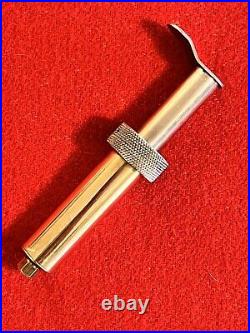

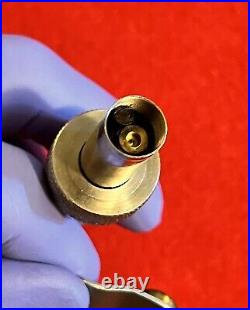
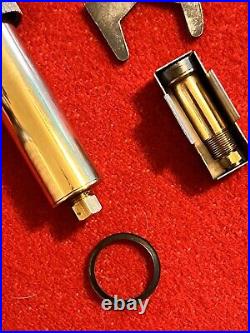
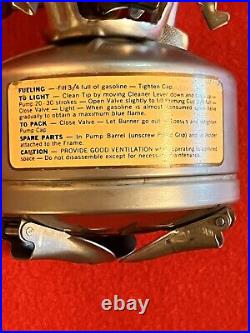

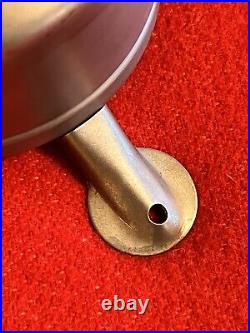
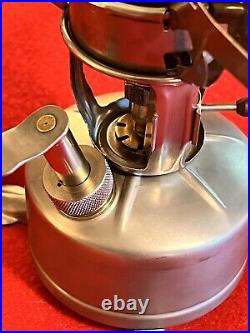
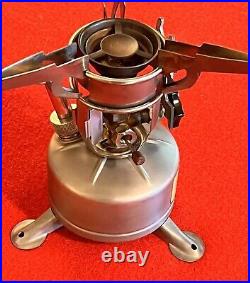
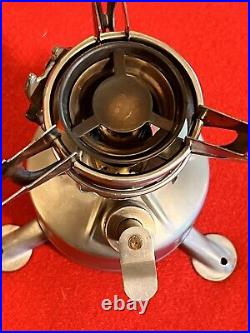
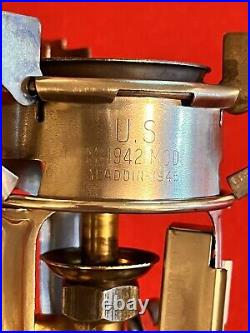
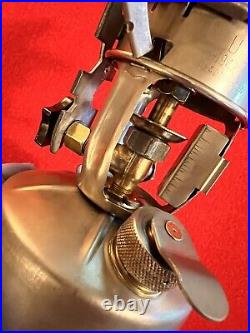
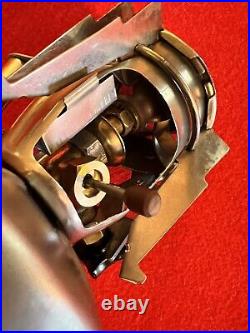

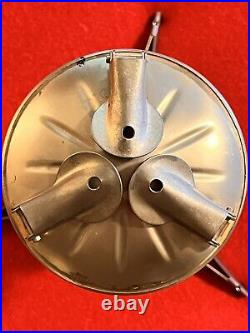
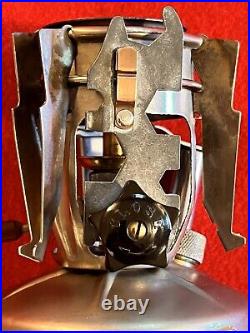
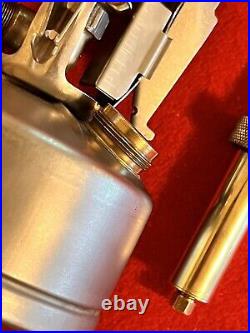
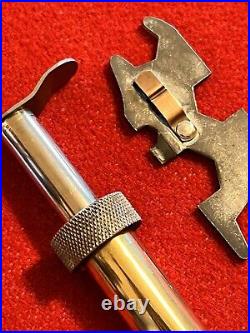
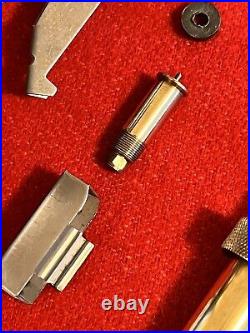
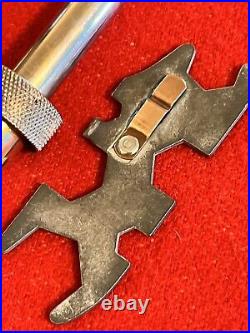
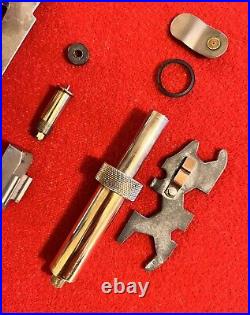
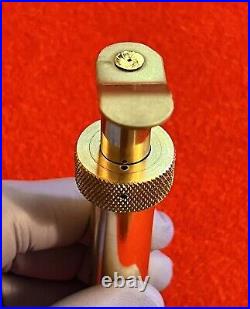


WWII Mountain/Ski STOVE, Complete! This is a STUNNING example! Bright, glistening, clean STAINLESS STEEL, free of soot, corrosion and dents!! Only the slightest evidence of “heat discoloration” to the steel on’squared’ hinge ends of the Pot Support arms, from perhaps a single use of the stove! But appears to be operational! WWII M1942-Modified, single-burner, gas Mountain STOVE, Complete! Complete with all components! Stoves were manufactured only in 1944 and 1945. Aladdin was awarded contracts in both 1944 and 1945. The WINDSCREEN is crisply and legibly stamped. Contrary to popular opinion the issue of these durable, lightweight single-burner gas Stoves were NOT limited to the 10. Mountain Division, FSSF, the Mountain/Ski Troops, but were available to Armored personnel, Paratroopers, and ALL combat personnel. Its prototype was already in use by the U. This was just the ticket for the’foxhole chef’ — when you gotta have coffee, you gotta have coffee. Mountain Stove was a 17 oz. Folding tripod legs, and folding pot support arms with 1/2 pint fuel capacity that was capable of operating for 2 hours on one tank of leaded gas. It was designed specifically to operate in frigid temperatures. The pressure pump was combined with the filler cap and contained a second set of replacement parts in addition to those in the steel box-container that snapped onto one of the vertical supports for the windscreen. Clipped above the control valve knob was a combination wrench-screwdriver tool. This unit has it all! Included are each of the original components. The MULTI-PURPOSE WRENCH with machined-edge screwdriver blade (unique to the Aladdin model) is present! The stamped steel SPARE PARTS Box-container complete with it’s bright brass replacement VAPORIZER/GENERATOR, SCREEN, CLEANING NEEDLE, and graphite GASKET is present! An ADDITIONAL replacement set of. CLEANING NEEDLE, and an assortment of graphite GASKETS and extra PIPS are still neatly nestled inside the gleaming steel Pump Barrel! This stove has an original NEAR PERFECT sunflower-yellow INSTRUCTION LABEL (water decal)! An intact,’undamaged’ INSTRUCTION LABEL is the’sine qua non’ for the collector of these Stoves as the decal rarely survived more that several uses of the Stove, being very susceptible to damage from both gasoline and heat!! The decal includes instructions under the following headings. The tiny walnut CLEANING KNOB and the black (unique to the Aladdin model). Bakelite’ CONTROL KNOB with the word. In the “stylized” serif font unique to the. Model are present and move freely! The folding LEGS with their bright copper springs snap in place correctly! The knurled FUEL CAP is nickel-plated (unique to the Aladdin model), not brass, and is free of scratches or damage from pliers! The flexible rubber Fuel Cap GASKET is present! ZERO dents to the stainless steel TANK ; no welded repairs, no bends to the pot support arms, no scratches! The seal of leather pump CUP/GASKET is solid and the the pump generates pressure! In addition to being a very, very attractive example suitable for a static display, and although untested, I suspect is serviceable or could easily be brought up to operational standard. These very durable M1942-Modified Stoves have stood the test of time, and fortunately after-market washers, gaskets, are available from various sources such as Old Coleman Parts. How the Aladdin Lamp Came to Be. The Aladdin lamp has an amazing and rich history, that all started with the vision and innovation of Victor S. Johnson over a century ago. As a small boy on a farm in Nebraska, Victor Samuel Johnson Feb. 6, 1882 – Aug. 29, 1943 read the Arabian Nights story of Aladdin in a room of darkness except for the flickering yellow light of an open flame coal oil lamp. Later, as an adult, he found a new, bright light – it was called the “Practicus” from Germany. Johnson obtained rights to sell this lamp and then improved on its design. He would go on to call his new lamp the ” Aladdin, ” from the stories of his childhood, and the rest, is history. Timeline of Aladdin History. 1908 – Victor S. Johnson founded the Mantle Lamp Company of America in Chicago, Illinois. 1911 – First mantle designed and patented by Charles H. Smith for Aladdin, called the Kone Kap mantle, first used on Model 3. 1915 – The Aladdin Model 6 lamp won a gold medal at the Panama Pacific International Exhibition for the best kerosene lamp in the world. 1926 – The name of the company was changed to Aladdin Industries. 1926 – Johnson bought the Lippincott Glass factory in Alexandria, Indiana to make glass lamps, chimneys and shades. 1926 – A factory was built on a 13-acre site, which was incorporated into a village called Aladdin with 22 residents. 1926 – Agents were recruited to sell throughout the country door-to-door, leaving lamps in the home for an overnight trial. 1928 – The company turned solely to franchise dealers (some 15,000 in the 1930s). 1928 – Model 12 introduced the first Lox-On chimneys and the first Lox-On mantles. 1931 – The Lox-On Mantle is patented. 1932 – Model A introduced a switch from central draft to “Nu-Type” side draft burners; with the center draft tube removed, lamp fonts could now be made of glass as well as metal. 1937 – Ohio River flooded Louisville and Cincinnati; Aladdin rushed lamps to thousands stranded without power. 1944 – Aladdin aided the war effort in WWII: they were granted permission by War Production Board to use copper to make burners which reduced need for copper wire to electrify homes; burners used in Servel refrigerators helped preserve serum and plasma on the battlefields; Aladdin also developed the midget foxhole stove, pressure lantern, barometric bomb detonation fuse, and permeability tuning for radios and precision parts for military radio equipment. 1945 – Victor S. 1949 – The Mantle Lamp Company merged with its subsidiary Aladdin Industries, Inc. 1949 – The company moved the central office from Chicago to Nashville, Tennessee. Background and History of the M1942-Modified Stove. From the absolutely exceptional SKICOLORADO’S BLOG: STEVE’S LIFE IN COLORADO. In November 1939, the Soviet Union invaded Finland in what is known as the Winter War. The battle lasted just over 3 months and ended with the Moscow Peace Treaty in March of 1940. The Soviet forces greatly outnumbered the Finnish military in soldiers, aircraft and tanks, however, their losses were more than 5 times greater. Many around the globe took notice of the Finn’s guerrilla tactics, using ski troopers on cross-country skis and wearing white capes as camouflage. It is also interesting to note that only two months prior to the Soviet invasion, Germany invaded Poland. Back in the U. Skiing advocates were encouraging the Army to develop a training system to produce our own ski troopers and rock climbers, especially after seeing the success of the Finnish troopers. What surprises me a little is that, amidst the Great Depression of the late 1930s, there were outdoors-men who were climbing and skiing around the country. Somehow, I just never visualized that skiing was going on during the Great Depression. Contrast that activity with my father’s childhood memory of growing up in Chicago in the late 1930s and 1940s, when he said to me, You know that saying,’If the shoe fits wear it’? When I was a kid, we’d go to school and there was a big pile of used shoes in the hallway. We were all kinda’ poor, so the teachers would say,’Here are some shoes. If the shoe fits wear it’. I wonder if that’s where that saying came from? Anyway, the Great Depression was a time experienced differently for many people. In 1941, and likely prior to December 7. And under the deadline of 60 days, the Coleman Company of Wichita, Kansas, was given the charge of producing a quart-sized, all-weather, single-burner stove which could be carried by a soldier. In record time, they produced the Coleman 520 stove, and seems to have been designated by the military as the M-1941 (though its actual full military designation is still unclear), which is the common term used by people to describe the AGM version. A second company, American Gas Machine Company (AGM), of Albert Lea, Minnesota, was also contracted to manufacture the Coleman design. According to documents I’ve read, over one million of these 520 stoves were produced during the war. The 520/M-1941 first saw service during the Africa campaign beginning in late 1942. By the time the Africa campaign began in 1942, construction of Camp Hale, in Colorado, was pretty much completed and U. Ski troopers were being trained in skiing, climbing, winter survival and ordinance. Camp Hale eventually became known for its 10th MOUNTAIN DIVISION. Somewhere, in this same time-frame, BESTOR ROBINSON, a lawyer, mountaineer and director of the Sierra Club in California prior to WWII, was assigned to a team at the U. Army’s Office of the Quartermaster General with the role of improving clothing and equipment for the army’s mountain divisions. The team was led by Robert Bates, who was an avid mountaineer, and it’s worth reading his short bio. During this time, Robinson, was granted patents for the design of a compact stove, which is regularly called the “mountain stove” by many today. His patent designs for the stove and various parts of it can be found by searching the web for these numbers: Patent No. The contract to build the new little stove was apparently awarded to the Aladdin Industries subsidiary of the Mantle Lamp Company of America or Mantle Lamp themselves, and manufactured under the name Aladdin , similar to the parent company’s well-known lamps. It’s kind of confusing exactly who made it, since The Mantle Lamp Company made Aladdin lamps, and they had a subsidiary with the same name, plus, Mantle Lamp eventually merged with Aladdin. Aladdin is still in business today. You may be familiar with some of their products which sell under the Stanley vacuum bottle name and other food and beverage containers. The first model of the stove is commonly called the “wheel stove”, by many collectors, because of the horizontal wheel used to operate the stove’s burner. My understanding is that the wheel design was to allow troopers to operate the stove in cold weather without removing their gloves or mittens. This model was only made by Aladdin and only in 1943. For reasons unknown to me, the stove was modified from the wheel design to one somewhat more conventional after only one year, particularly in the valve stem. This second stove model is known, and is stamped, as the M-1942 MOD, where MOD denotes modified. The model was also produced by Aladdin in 1944, and Prentiss Wabers a. Known as Preway of Wisconsin Rapids, Wisconsin and possibly by one other company (possibly Coleman), however, I have been unable to confirm this. In 1945, the M-1942 MOD was produced by Aladdin, Prentiss Wabers and Coleman. I’ve never seen manufacturing year stamps past 1945, so it appears that the stove was very short-lived with a production run of only three years.


























